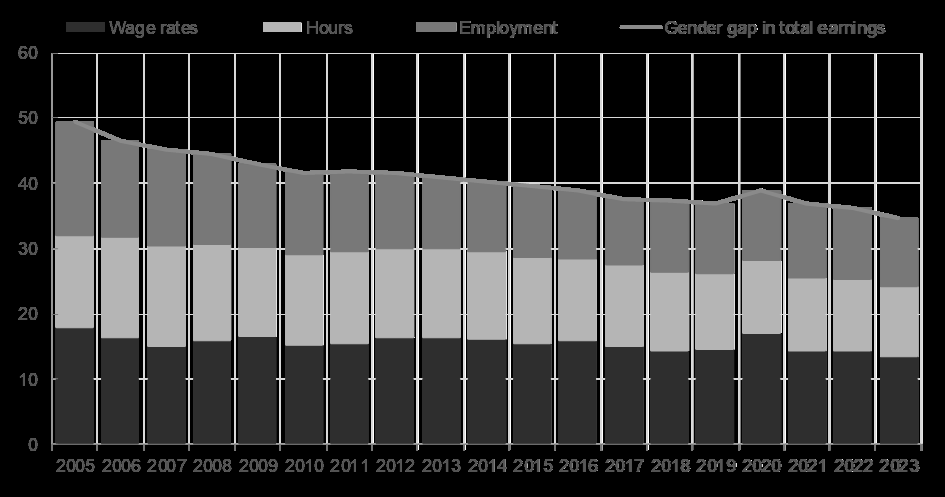7 March 2024
The gender gap in labour markets is narrowing. But this process has slowed down. The ECB Blog gives an
overview of recent developments for all euro area countries.
The gender gap at work is closing – but slowly. Women are paid less for their work than men are.[1] Inequality on the labour market keeps us from making the best
use of all talent, leads to inefficiency and misallocation of workers. However, the gender gap is shrinking,
albeit at a decreasing speed. We show the differences between women and men on the labour markets in hours
worked, part-time positions, wages and total earnings for all euro area countries.[2] Our interactive graphs let you compare the developments in gender inequality among
countries and over time.
Gender gaps in the euro area labour market
Based on an analysis using household-level data from the EU Survey on Income and Living Conditions (EU-SILC) we
find that the gender gap in total earnings has improved significantly. In 2005 it stood at 50%, meaning that the
average man took home double the yearly pay of the average woman (aged 15 to 64). By 2023 this had fallen to 35%
(Chart 1).[3] While this change is significant, the gap in the
euro area remains quite large. In addition, the speed at which it is narrowing is slower than two decades ago.
Chart 1
Gender gap in total earnings
Percentage of the mean earnings for the average male aged 15-64; and percentage point
contributions

Sources: Eurostat, EU SILC, and ECB staff calculations. Notes: The decomposition of the
gender gap in total earnings follows the methodology in Olivetti, Pan, and Petrongolo (2024), and
Andrew, Bandiera, Costa Dias and Landais (2024), which decomposes the effects in three different
gaps – (1) the hourly wage gap, (2) the gap in the number of hours worked, and (3) the employment
participation gap.
Three main elements of the gender wage gap
A major factor behind the gender gap is the different labour participation rates of men and women. In 1992 the
employment rate of women (44.8%) was 27.8 percentage points lower than that of men (72.7%) across today’s euro
area countries (Chart 2).[4] This was because women often
struggled to find stable jobs and – to a greater extent than men – took care of their households. Since then
female employment has increased gradually, reducing the gap to 9.0 percentage points by 2023. The red bar in
Chart 1 shows how the shrinking employment gap – from 17.3 in 2005 to 10.5 percentage points in 2023 –
contributed to a similar decrease in the gender earnings gap.
A second factor is the different patterns for part-time work. Women remain significantly more likely to work
part-time than men. While in the 1990s the rate of women in part-time contracts was 21.5 percentage points
higher than that for men, by the mid-2000s this figure had grown to 26.9 percentage points before shrinking
slightly to 24 percentage points by 2024 (Chart 3). This discrepancy contributes to the gender gap in total
earnings because it affects the hours usually worked by men and women. It accounted for 14.1 percentage points
of the earnings gap in 2005, falling to 10.7 percentage points by 2024. This decrease could be associated with
an increase in the average hours worked by women in part-time employment, mitigating the effects from a large
gap in part-time employment. In other words, women work part-time more often, but female part-timers have
increased their hours over time.
A third factor is the hourly pay gap. This figure measures how much more the average man earns per hour than the
average woman. In 2023 it stood at 13.4%, down from 17.8% in 2005, with an average annual decrease of only 0.2
percentage points.
What is behind this sluggish change? While education might appear to be a likely factor, women now in fact have a
slightly higher average level of education than men, meaning that the cause must lie elsewhere. One explanation
is the existence of clusters. Some occupations are more male-orientated, like firefighting or engineering, while
others are more female-orientated, like nursing or teaching. And some of the male-orientated jobs simply pay
better. Other explanations relate to norms and beliefs about gender roles, men and women’s different
preferences, or women’s more limited possibilities to change jobs due to external constraints.[5] And of course there is also the possibility of simple
discrimination. Because even when we control for additional factors such as average years of employment or
maternity leave periods, there is still an unexplained wage gap. In Germany, for example, this unexplained gap
stood at 6% in 2024. This is the average difference in pay between female employees and male employees with
comparable job qualifications and career paths.
Regional patterns: gender gaps in different countries
While we find that the gender gap is narrowing across the euro area, there are significant regional differences.
These depend on labour market features, national policies and culture, as shown in interactive Charts 2 and
3.[6] In northern countries, especially Finland for example, the
gender pay gap is quite small. Use the “select” option in the toolbar to explore the situation in other
countries. The gap in working time, however, is still significant. In Eastern Europe, for example the Baltic
countries, you will find a more equal working environment in terms of both employment rates and hours worked.
This has been attributed to the legacy of socialism,[7] which
promoted women’s economic inclusion. In Western Europe men’s and women’s employment rates have converged, with
many women entering the workforce, often in part-time jobs, and in particular in Austria, Germany and the
Netherlands. Meanwhile in Southern Europe the gender gap in employment has also narrowed significantly, driven
by a higher share of women being in full-time rather than part-time employment. Portugal, which has historically
had small gender gaps in employment, is a particular success case in this region.
If governments aim to close the gender gap in labour markets, public policies should be targeted towards barriers
faced by girls and women, for example with paid parental leave policies and investments into the childcare
system. Academic studies have highlighted the importance of childcare, especially during the first few years, on
women’s labour market participation.[8] Increasing the time
fathers can spend with their young children would also help reduce the “child penalty” women face in the labour
market and their unequal burden at home.
Closing the gap
But these public policies cannot fully tackle every cause of gender gaps in the workplace, which are usually
linked to discrimination and unconscious bias against women. Steering young women and girls towards more
scientific careers, for example, could help to reduce existing gender gaps by opening up alternatives that women
traditionally do not consider. Institutional initiatives such as mentorship programs, networking opportunities,
and training and development programs can also help to empower women and provide them with the tools they need
to succeed. By addressing the barriers to women’s participation and promoting gender equality, we can create a
more inclusive and diverse workforce that benefits everyone. However, closing the gap is not solely an issue for
women. New fathers should also have the opportunity to take care of their newborns, possibly via more generous
paternity leave policies, and access to childcare should be improved. All these actions taken together would
help addressing what the Nobel Prize laureate Claudia Goldin
referred to as the “last chapter” in achieving gender equality.
The views expressed in each blog entry are those of the author(s) and do not necessarily represent the views
of the European Central Bank and the Eurosystem.
Check out The ECB Blog
and subscribe for
future posts.
For topics relating to banking supervision, why not have a look at
The Supervision Blog?
“The European Central Bank is the prime component of the Eurosystem and the European System of Central Banks as well as one of seven institutions of the European Union. It is one of the world’s most important central banks.”
Please visit the firm link to site



